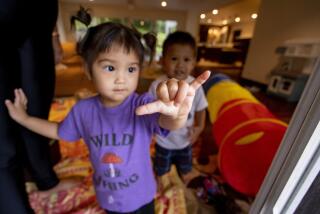O.C. Family : In the Spirit of the Dance : True Hawaiian Culture Offered at E Hula Mau Competition in Irvine
- Share via
A hula and chant festival or a hula and chant competition. These were the two options facing the Fullerton-based Na Mamo when the Hawaiian organization began considering the type of cultural event it wanted to present.
“Initially we thought a festival would be much more friendly,” says Na Mamo member and marketing director Bernadette Ahuna.
“But we decided to make it a competition so that people would see something more authentic since the participants would be rated and critiqued. They would be told [by judges] what is appropriate and what is not. We don’t like the connotation of competition, but it’s needed to help [the dancers and chanters] take what they do seriously.”
Now in its fifth year, this weekend’s three-day hula and chant competition at UC Irvine may be the best opportunity for Southern Californians to witness genuine hula dancing and chanting.
Hawaiian arts and crafts booths and exhibitions will also be featured during the event, which begins Friday and continues through Sunday. One of the main objectives of the competition, titled E Hula Mau Hula & Chant Competition, is to perpetuate the ancient traditions and symbols associated with authentic hula.
In its purest form, hula is a sacred art that carries with it history, custom, ceremony and genealogy. Burbank-based hula instructor Kunewa Mook was a key figure in bringing traditional hula back to Southern California. A kumu hula (master instructor), Mook stopped teaching when he moved from his native Hawaii to California more than 30 years ago.
But in the mid-’80s, he decided to start a hula studio in Burbank after discovering that the traditions and deeper meanings of hula were being lost in Southern California.
“The reason I went back into hula was because I didn’t like what I was seeing in hula,” he says. “I was taught by the best in Hawaii. I thought, ‘This is not hula.’ It was just getting up there and doing shows and not caring what you’re doing. I said, ‘We have to go back to tradition.’ All they did was the modern style [of hula]. But [even then] they didn’t understand what they were doing. They were just dancing [without a deeper understand of the history and symbolism behind hula].”
E Hula Mau is an event that Mook takes very seriously. During the month of August, he and his mostly young adult students practiced nightly during the week and every Saturday and Sunday. His troupe has participated in this competition twice before, and Mook says his students usually finish first or second in the categories they enter.
Much effort goes into choreographing routines. But choosing the appropriate costumes and leis that the performers wear can be nearly as important. “All flowers have representations [in hula],” reveals Ahuna. “Everything is very symbolic. There’s all this other additional information that’s coming out from the colors and patterns they use. It usually represents something in the interpretation of their dance.”
E Hula Mau includes four performance categories. There are two group divisions. One is devoted to ancient (kahiko) hula; the other features modern (auana) hula. Ancient hula is accompanied only by chanting and percussion. (Chanters and drummers usually perform at the side of the stage while the dancers take center stage.)
Modern hula uses stringed instruments as well as lyrical songs. The competition also features solo and couples dance categories. It’s the chanting that connects most strongly to the sense of cultural pride and history among many Hawaiians.
“The chant is the heartbeat of our culture because it is our language,” Ahuna explains. “It’s how we tell about our past and where we intend to go in the future. Everything you hear usually describes a time, a place, a person, an emotional experience. It’s very honoring and spiritual.”
Most hula dancers are female. But Ahuna says it’s the male performers who usually generate the most fevered audience responses. Many male dances are high-energy affairs celebrating such important occasions as battles or a boy’s passage into manhood or key figures such as kings.
Because the organizers of E Hula Mau want to encourage Hawaiian expatriates and non-Hawaiians to participate in their event, Hawaiian-based hula artists are excluded from the competition.
Ahuna says mainlanders may resist entering the contest if they have to compete against more seasoned participants from the Hawaiian Islands, where hula is very much interwoven into the popular culture.
Several other Hawaiian-themed events are tied into the E Hula Mau competition. No Mamo will sponsor a barbecue buffet dinner and dance at the Atrium Hotel in Irvine on Saturday night. The Ho’olaulea Celebration will feature four live bands, Hawaiian music and a dinner featuring such dishes as Lomi Lomi salmon, Hawaiian chicken, teriyaki beef, vegetable stir fry, sticky rice and macaroni salad.
On Sunday night, popular Hawaiian vocalist Keali’i Reichel will perform at the Bren Events Center. Reichel does incorporate Western elements into his music, but Ahuna says he is mainly a traditionalist who sings mostly in Hawaiian and is loved for his romantic melodies.
His show also features a cast of hula dancers. Ahuna expects between 20,000 and 30,000 people to attend the E Hula Mau competition and its related events. Many will be Hawaiian transplants who didn’t gain a full appreciation of their native culture until they moved to the mainland.
“The young people who leave the islands and end up living here often say, ‘When we were in Hawaii, we weren’t interested in anything Hawaiian,’ ” says Ahuna. “Then they realized what they were missing when they left. They feel homesick because suddenly they don’t have [Hawaiian culture] in their lives. I think that’s why E Hula Mau has been so successful. They want to participate in events that depict home in a quality way.”
BE THERE
The E Hula Mau Hula & Chant Competition takes place at the Bren Events Center on the campus of UC Irvine. The solo and couples performances take place Friday between 3:30 p.m. and 10 p.m.; the ancient group and chant performances take place Saturday between 10 a.m. and 4 p.m.; the modern group performances and the awards ceremony are scheduled for Sunday between 9 a.m. and 5 p.m. $10-$15 per day. (949) 824-5000 or (310) 543-1259. The Ho’olaulea Celebration is Saturday night at the Atrium Hotel, 18700 MacArthur Blvd., Irvine. 5:30 p.m.-1:30 a.m. $19.95; ages 9 and younger, $13. (800) 854-3012 Ext. 417. Keali’i Reichel performs at the Bren Events Center Sunday at 7:30 p.m. $25. (949) 824-5000.
More to Read
The biggest entertainment stories
Get our big stories about Hollywood, film, television, music, arts, culture and more right in your inbox as soon as they publish.
You may occasionally receive promotional content from the Los Angeles Times.










